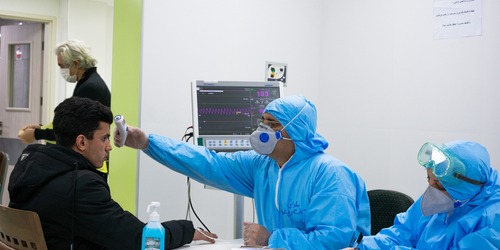How Iran is doubling down on medical tourism
Despite international sanctions and economic instability, Iran’s medical tourism sector is increasingly attracting Muslim patients with offerings that cater specifically to their needs, such as halal pharmaceuticals, same-gender physicians, and competitive treatment costs.
Over the past year alone, the country welcomed an estimated 1.2 million medical tourists, contributing approximately $1 billion to the economy, according to state-owned media. This growth reflects a rising global demand for Iran’s affordable, high-quality healthcare services.
Globally, the demand for medical tourism continues to rise, fueled by factors such as lengthy waiting times in public healthcare systems, high costs of private treatment, and inadequate insurance coverage in many countries.
A 2020 study found that medical treatments in Iran cost up to 65% less than in the United States and 40% less than in Western Europe, making the country a leading destination for affordable, high-quality healthcare.
This cost advantage, paired with Iran’s emphasis on quality care and improving infrastructure, has firmly positioned it as a competitive player in the global medical tourism market.
“The Iranian government has prioritized medical tourism as part of its broader economic diversification strategy. Investments have been made in expanding and modernizing healthcare facilities to meet international standards,” says Mohammadreza Sheikhy-Chaman, assistant professor of health economics at the Tehran Medical Sciences Branch of Islamic Azad University.
Iran has streamlined visa procedures for patients and their companions, while hospitals across the country have established dedicated international patient departments staffed with multilingual professionals to facilitate seamless communication and care, he says.
Today, 247 hospitals and medical centers have been licensed to cater to international patients. These facilities attract individuals from neighbouring nations, including Iraq, Afghanistan, Pakistan, Oman, Bahrain, Armenia, and Tajikistan, as well as Iranian expatriates from Europe and North America.
According to Sheikhy-Chaman, the most sought-after treatments in Iran include cosmetic surgeries, fertility procedures, ophthalmology, organ transplants, and orthopedic care.
Iran has also emerged as a leading destination in West Asia for specialties such as dentistry and aesthetic treatments, earning international recognition for its expertise in rhinoplasty.
Key medical hotspots
Iran’s medical tourism industry is firmly rooted in its major urban centers, where cities like Tehran, Shiraz, Mashhad, and Isfahan boast internationally accredited medical facilities. Beyond the metropolitan centers, other regions in Iran are also emerging as popular destinations for health-focused travelers.
Ardabil, located in the mountainous northwest, is gaining recognition for its mineral hot springs, which are renowned for their therapeutic properties. The province underscored its potential as a medical tourism hotspot in 2023 by hosting an international health tourism seminar that showcased its hydrotherapy offerings.
Another rising star in Iran’s medical tourism landscape is Uramanat, a historic valley in the country’s Kurdistan province. Famous for its rare medicinal plants and traditional remedies, Uramanat’s charm is further enhanced by its proximity to neighbouring Iraq and its designation as a UNESCO World Heritage Site in 2021. These attributes, combined with its natural resources, position the region as a compelling destination for medical tourists seeking alternative therapies.
“Iran’s healthcare sector is experiencing substantial and rapid advancements,” says Mohammad Amin Shakeri, founder and CEO of Mashhad-based Elajiran Medical Tourism.
“For example, three Cyberknife machines [the world’s first and only robotic radiosurgery system] are being installed to bolster advanced treatment options. At the same time, the Ministry of Health has rolled out updated regulations for international patients’ departments to ensure higher standards of quality and safety in healthcare.”
The private sector is playing a crucial role in Iran’s medical tourism success, with organizations like Elajiran Medical Tourism driving growth through local agents in target markets such as Bahrain, Oman, and Afghanistan.
Dual-purpose trips
Iran's shared language and cultural ties with neighbouring countries, such as Iraqi Kurdistan, Turkiye, and Azerbaijan, present a unique opportunity to bolster its medical tourism industry. Additionally, the country’s strong appeal as a hub for cultural and religious tourism naturally intertwines with the growth of its medical tourism industry.
From the ancient ruins of Persepolis to the architectural splendor of the mosques in Isfahan, Iran’s cultural treasures can enrich the medical tourism journey. One standout destination is Mashhad, home to the holy shrine of Imam Reza, a magnet for both Muslim pilgrims and medical tourists.
“Many of Iran’s top medical tourism destinations, such as Shiraz, Isfahan, Mashhad, and Tehran, are located near iconic cultural and historical landmarks. For instance, Shiraz, known as the “City of Poets”, is home to world-famous sites like Persepolis and the tombs of Hafez and Saadi, while also offering top-tier medical facilities. This strategic overlap allows medical tourists to immerse themselves in cultural experiences while they recover,” says Sheikhy-Chaman.
An increasing number of hospitals and medical tourism facilitators in Iran are now providing all-inclusive packages that blend healthcare services with cultural experiences, he says. These packages not only address patients’ medical needs but also include guided tours to historical sites, vibrant bazaars, and revered religious shrines.
“Many medical tourists opt for extended stays in Iran, taking advantage of their recovery period to explore the country. For example, after undergoing treatments such as cosmetic surgery or dental procedures, patients often visit attractions like the Naqsh-e Jahan Square in Isfahan, the Caspian Sea region, or the picturesque deserts of Yazd.”
For Muslim medical tourists in particular, the journey can extend far beyond treatments - becoming an exploration of history, spirituality, and the promise of health.
“A lot of travellers combine their treatments with visits to sacred sites such as the holy shrines in Mashhad, Shiraz, and Qom,” says Shakeri, adding that Iran’s appeal extends to halal tourism enthusiasts and Muslim families thanks to its alcohol-free policies and hijab-related regulations.
